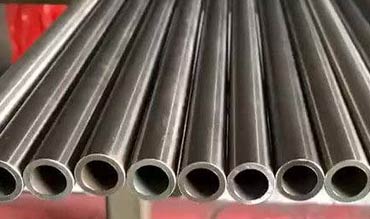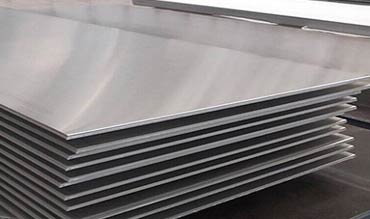Nickel

Nickel
Nickel is a naturally occurring, shiny, silvery-white metal. It is classified as a transition metal and is known for its hardness and ductility. Nickel offers outstanding resistance to corrosion and is commonly found in more than 300,000 products across various sectors, including consumer goods, industrial uses, military, transportation, aerospace, marine, and architectural applications.
Characteristics of Nickel
- High temperature resistance
- Corrosion resistance
- High electrical conductivity
Applications of Nickel
- Electronics
- Chemical and petrochemical processing
- Processing equipment for maintaining product purity in handling foods, synthetic fibers, and alkalies
Shah International supplies the below Nickel Grades in the form of pipe ,tubes ,plate, sheet : Nickel 200/201

UNS Number N02200/N02201l
Nickel 200 and Nickel 201 are commercially pure, solid solution strengthened wrought materials that offer good mechanical properties across a wide temperature range and exceptional resistance to various corrosive environments, particularly hydroxides. Nickel 201 is a modified version of Nickel 200, designed to reduce carbon content (with a maximum of 0.02%), preventing embrittlement caused by intergranular precipitates when exposed to temperatures between 600°F and 1400°F in many processes. In most cases, the elemental specifications of both Nickel 200 and Nickel 201 are combined into a single dual-certified alloy, known as Nickel 200/201, which offers the desired properties of both materials.
Characteristics of Nickel 200/201
- Highly resistant to various reducing chemicals
- Excellent resistance to caustic alkalies
- High electrical conductivity
- Excellent corrosion resistance to distilled and natural waters
- Resistance to neutral and alkaline salt solutions
- Excellent resistance to dry fluorine
- Widely used to handle caustic soda
- Good thermal, electrical, and magnetostrictive properties
- Offers some resistance to hydrochloric and sulfuric acids at modest temperatures and concentrations
Nickel 200 (UNS N02200) Chemical Composition, %
Ni |
Fe |
Cu |
C |
Mn |
S |
Si |
99.0 min |
0.40 max |
0.25 max |
0.15 max |
0.35 max |
0.01 max |
0.35 max |
Nickel 201 (UNS N02201) Chemical Composition, %
Ni |
Fe |
Cu |
C |
Mn |
S |
Si |
99.0 min |
0.40 max |
0.25 max |
0.02 max |
0.35 max |
0.01 max |
0.35 max |
Applications of Nickel 200/201:
- Production and treatment of caustic soda
- Production of synthetic fibers and soaps
- Food manufacturing such as handling of cooling brine, fatty acids and fruit juices due to the material’s resistance against acids
- Marine and offshore engineering
- Alkalis and neutral salt solutions and against organic acids
- Tanks in which fluorine is produced and where it reacts with hydrocarbon (CFC) due to the material’s resistance against fluorine
- Production of hydrogen chloride and chlorination of hydrocarbons such as benzene, methane and ethane
- Production of vinyl chloride monomer due to the material’s resistance against dry chlorine gas and hydrogen chloride in increased temperatures
- Electrical and electronic components
- Electrode contacts and current conductors in batteries
- Current conductors in alkali fuels
- Storage and transport of phenol
Machining and Fabrication with Nickel 200/201

Nickel 200/201 can be readily hot-formed to practically any shape. Proper temperature during deformation is the most important factor in achieving hot malleability. The recommended temperature range for hot forming is 1200° to 2250°F (650° to 1230°C). All heavy forging should be done above 1600°F (870°C); the metal stiffens rapidly below this temperature. Light forging below 1200°F (650°C), however, will produce higher mechanical properties. Laboratory experiments on forged discs for ring applications have indicated that tensile properties at 1200°F (650°C) can be increased by upsetting the material 50% at 1200°F (650°C). The best temperature range for hot bending is 1600° to 2250°F (870° to 1230°C). Nickel 200/201 tends to flow under pressure of the tool cutting edge and form long stringy chips. To avoid a built-up edge, tools should be ground with very high positive rake angles; 40° to 45° rake angles have been used in some instances. High-speed-steel or cast-alloy tools should be used. Chip action is substantially better with material in the harder tempers, so that cold-drawn rod in the as-drawn or stress-relieved temper will offer an improvement over annealed material.
Nickel 200/201 ASTM Specifications:
Pipe Smls |
Pipe Welded |
Tube Smls |
Tube Welded |
Sheet / Plate |
Bar |
Fitting |
B161 |
B622 |
B161 |
B622 |
B162 |
B160 |
B163 |
Welding Wire Designations:
AWS A5.14 – ERNi1 (Nickel Ti)
AWS A5.14 – Nickel Wire (Pure Nickel Wire)
Mechanical Properties of Nickel 200/201:
Typical Room Temperature Tensile Properties of Annealed Material
Product Form |
Tensile Min. (ksi) |
0.2% Yield Min. (ksi) |
Elongation Min |
Rod & Bar |
110.0 |
52.6 |
62 |
Sheet/Plate |
107.4 |
50.3 |
67 |
Welded Pipe & Tube |
115.5 |
54.6 |
60 |
Seamless Pipe & Tube |
105.4 |
45.4 |
70 |
